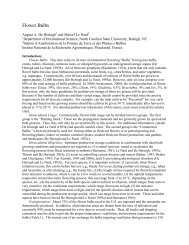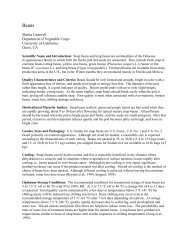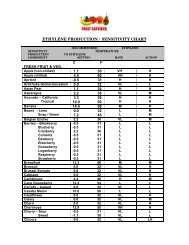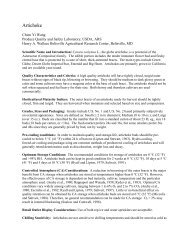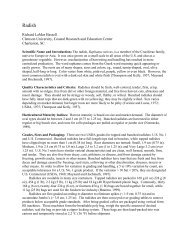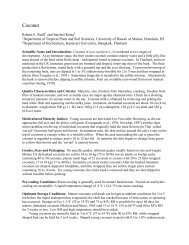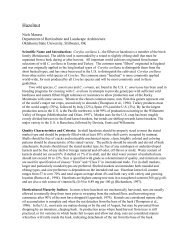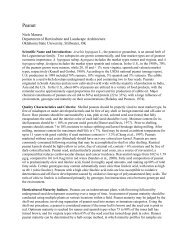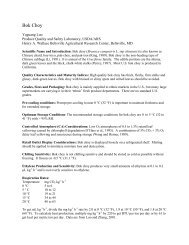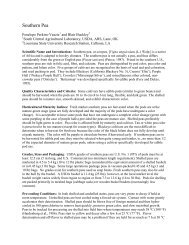Prickly Pear
Prickly Pear
Prickly Pear
- No tags were found...
Create successful ePaper yourself
Turn your PDF publications into a flip-book with our unique Google optimized e-Paper software.
Retail Outlet Display Considerations: Fruit should be kept cold to reduce dehydration. At retail, thesurface of cactus fruit may appear dull due to water loss.Ethylene Production and Sensitivity: <strong>Prickly</strong> pear fruit produce very low amounts of ethylene at about0.2 µL kg -1 h -1 at 20 °C (68 °F), and are not sensitive to ethylene exposure.Respiration Rates: Fruit are non-climacteric and respiration rates are low during storage. Therespiration rate at 20 ºC (68 ºF) is 27 to 36 mg (15 to 20 µl) CO 2 kg -1 h -1 . Heat production is about 7,000BTU ton -1 day -1 or 1,900 kcal tonne -1 day -1 .Physiological Disorders: See section on “Chilling Sensitivity.”Postharvest Pathology: Harvest damage to the peel and stem-end of cactus fruit will lead to attack bynumerous pathogens and result in fruit decay. Common postharvest pathogens on cactus fruit are mostlyfungi and include Fusarium spp., Alternaria spp, Penicillium spp, but yeasts and bacteria also causedecay. Hot water dips at 53 to 55 °C (127 to 131 °F) for 5 min and fungicide-containing waxes mayreduce surface decay, but are not effective when there is damage to the stem-ends. For control of decayon stem-ends, see “Special considerations.” Pre-harvest calcium sprays result in less postharvest decay(Schirra et al., 1999).Quarantine Issues: None.Suitability as Fresh-cut Product: Even after brushing and washing, the peel of intact cactus fruit mayhave irritating small spines, and a peeled packaged fruit product could be a useful option. A mixture ofCactus fruit of different colors and types could be a potentially attractive product.Special Considerations: Fruit can be bruised easily by finger compression during harvest, but damage tothe stem-end is by far the most serious mechanical injury. Damage at the stem-end can be eliminated bycareful harvest (twisting fruit from the stem or cutting fruit with a small piece of stem attached). Fruitharvested with a bit of stem may be packed that way or cured under moderate temperature of 15 to 20 °C(59 to 68 °F) with airflow so the bit of stem dries and falls off before fruit are packed. This preventsdamage to the stem end and greatly reduces decay incidence. High-gloss fruit waxes are often used toimprove visual appearance and reduce dehydration. This is especially important if fruit are dry-brushedto remove small tufts of spines or glochids.References:Cantwell, M. 1995. Postharvest management of fruits and vegetable stems. In: Agroecology, Cultivationand Uses of Cactus <strong>Pear</strong>. G. Barbera, P. Inglese and E. Pimienta-Barrios (eds) FAO PlantProduction and Protection Paper No. 132, Rome Italy, pp. 120-136.Kader, A. 2000. Cactus (<strong>Prickly</strong>) <strong>Pear</strong>. Produce Facts. Recommendations for Maintaining PostharvestQuality at http://postharvest.ucdavis.edu/produce.Lakshminarayana, S., L. Alvarado y Sosa and F. Barrientos-Pérez. 1979. The development andpostharvest physiology of the fruit of prickly pear (Opuntia amyclaea Tenore). In: Tropical Foods.Vol 1. Chemistry and Nutrition, G.E. Inglett and G. Charalambous (eds), Acad. Press, NY, pp. 69-93.Piga, A., S. D’Aquino, M. Agabbio and M. Schirra. 1996. Storage life and quality attributes of cactuspears cv. “Gialla” as affected by packaging. Agr. Med. 126:423-427.Schirra, M., M. Agabbio, S. D’Aquino and T.G. McCollum. 1997. Postharvest heat conditioning effectson early ripening ‘Gialla’ cactus pear fruit. HortScience 32:702-704.Schirra, M., P. Inglese and T. La Mantia. 1999. Quality of cactus pear [Opuntia ficus-indica (L.) Mill.]



